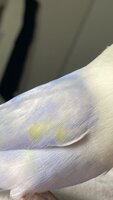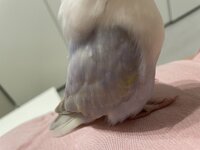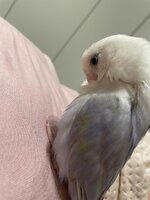-
Welcome to Avian Avenue! To view our forum with less advertisments please register with us.
Memberships are free and it will just take a moment. Click here
Pictures spots
- Thread starter Rema
- Start date
Looks like psitticin.
Do you have a pic of your entire bird? I need to see the species and it's mutation.
Do you have a pic of your entire bird? I need to see the species and it's mutation.
Shezbug
ASK ME FOR PICTURES OF MY MACAW!
Super Moderator
Avenue Veteran
Celebirdy of the Month
Mayor of the Avenue
Avenue Spotlight Award
TAILGATING
Cutest Bird Ever!!!
What is Psitticin?Looks like psitticin.
Do you have a pic of your entire bird? I need to see the species and it's mutation.
I can't find anything under that spelling and when I did a search as it just keeps correcting it to Psittacine and brings up PBFD pics.
Edit: I believe it is a lovebird going by looking at what is available and given it is in lovebird lane I am even more inclined to think it def is a lovie.
Zara
♥❀Livin´ in Lovebird Land❀☼
Super Moderator
Avenue Veteran
Celebirdy of the Month
Mayor of the Avenue
Avenue Spotlight Award
Avenue Concierge
TAILGATING
Cutest Bird Ever!!!
I agree with Tim.
Some of my Turquoise lovebirds also gained green/yellow spots at a few years old instead of during the first moult.
Wild type lovebirds have both and therefore look green with red faces.
My Sydney has a mutation that has a very large reduction of eumelanin so he looks yellow. And my oher birds have reductions of psittacin so they look blue with white faces (and some have eumelanin reduction on top of that)
Some of my Turquoise lovebirds also gained green/yellow spots at a few years old instead of during the first moult.
In short, it is what creates the yellow and red colours. Eumelanin creates the blue.What is Psitticin?
Wild type lovebirds have both and therefore look green with red faces.
My Sydney has a mutation that has a very large reduction of eumelanin so he looks yellow. And my oher birds have reductions of psittacin so they look blue with white faces (and some have eumelanin reduction on top of that)
Zara
♥❀Livin´ in Lovebird Land❀☼
Super Moderator
Avenue Veteran
Celebirdy of the Month
Mayor of the Avenue
Avenue Spotlight Award
Avenue Concierge
TAILGATING
Cutest Bird Ever!!!
To be more specific, one just got green spots in this current, ongoing moult on both wings and they just turned 3 at the beginning of this month.Some of my Turquoise lovebirds also gained green/yellow spots at a few years old instead of during the first moult.
Shezbug
ASK ME FOR PICTURES OF MY MACAW!
Super Moderator
Avenue Veteran
Celebirdy of the Month
Mayor of the Avenue
Avenue Spotlight Award
TAILGATING
Cutest Bird Ever!!!
Thanks.I agree with Tim.
Some of my Turquoise lovebirds also gained green/yellow spots at a few years old instead of during the first moult.
In short, it is what creates the yellow and red colours. Eumelanin creates the blue.
Wild type lovebirds have both and therefore look green with red faces.
My Sydney has a mutation that has a very large reduction of eumelanin so he looks yellow. And my oher birds have reductions of psittacin so they look blue with white faces (and some have eumelanin reduction on top of that)
None of my searches came up with anything about psitticin- nothing about mutations either - just kept offering alternatives to the word psitticin.
Zara
♥❀Livin´ in Lovebird Land❀☼
Super Moderator
Avenue Veteran
Celebirdy of the Month
Mayor of the Avenue
Avenue Spotlight Award
Avenue Concierge
TAILGATING
Cutest Bird Ever!!!
That´s a typo. Psittacin may be a more fruitful search.psitticin
Zara
♥❀Livin´ in Lovebird Land❀☼
Super Moderator
Avenue Veteran
Celebirdy of the Month
Mayor of the Avenue
Avenue Spotlight Award
Avenue Concierge
TAILGATING
Cutest Bird Ever!!!
@Shezbug I just dug into my book and found this is also called Psittacofulvin
lol and yes, I still didn´t fix my mouse
psittacofulvin - Google Search
www.google.com
lol and yes, I still didn´t fix my mouse

Shezbug
ASK ME FOR PICTURES OF MY MACAW!
Super Moderator
Avenue Veteran
Celebirdy of the Month
Mayor of the Avenue
Avenue Spotlight Award
TAILGATING
Cutest Bird Ever!!!
I actually tried that too. I really didn’t get much suggested that wasn’t about psittacine diseases lol.That´s a typo. Psittacin may be a more fruitful search.
Psittacin is responsible for some of the coloring in Lovebirds feathers. It's responsible for the YELLOWS and REDS.
The Blue mutation is where a bird lacks pstittacin. So take a Green Fischer Lovebird for example. A Blue Fischer Lovebird has none of the red or yellow coloring anymore, just a Blue body and white face and nape. The body is Blue because the yellow coloring is removed from the green color.
I know the OP's bird is a Lovebird, I was inquiring which species or mutation. If it's an eyering lovebird, then the bird could be an actual Blue mutation and the spots could be something else. If it's a peachaced, then the Blue mutation doesn't exist and the spots would be caused by psittacin ramping up in the Turquoise body.
The Blue mutation is where a bird lacks pstittacin. So take a Green Fischer Lovebird for example. A Blue Fischer Lovebird has none of the red or yellow coloring anymore, just a Blue body and white face and nape. The body is Blue because the yellow coloring is removed from the green color.
I know the OP's bird is a Lovebird, I was inquiring which species or mutation. If it's an eyering lovebird, then the bird could be an actual Blue mutation and the spots could be something else. If it's a peachaced, then the Blue mutation doesn't exist and the spots would be caused by psittacin ramping up in the Turquoise body.
Last edited:
helloLooks like psitticin.
Do you have a pic of your entire bird? I need to see the species and it's mutation.
same as my lovebird ,check the pictures, is it what you mean?To be more specific, one just got green spots in this current, ongoing moult on both wings and they just turned 3 at the beginning of this month.
Attachments
-
89.7 KB Views: 4
-
79.6 KB Views: 4
-
72.5 KB Views: 5
-
112.4 KB Views: 5
Your beautiful bird is a Peachfaced Lovebird. There is no genetic Blue mutation in Peachfaced like there is in Blackmasked and Fischer Lovebirds. The only colors that exist in Peachfaced lovebirds are Green and Parblue (Partial Blue). Over the years, breeders were able to breed the yellow out of Parblue birds to mimic the Blue mutation. Genetically the bird is still a Parblue, but it looks like a Blue. Unfortunately the bird is still what it is, and sometimes as the bird matures a limited amount of the yellowing substance will be produced and show in your birds feathers. This is about as simple as I can make this, so I hope you understand. 







